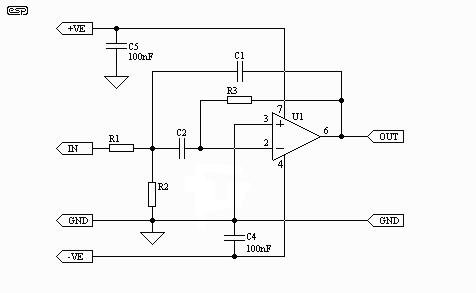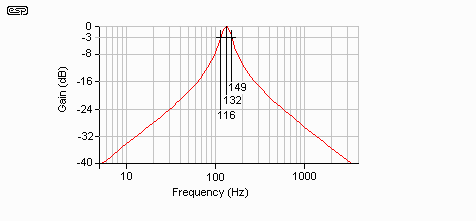
 |
The
Audio Pages
|
| Elliott Sound Products | Project 63 |
The multiple feedback bandpass filter is a simple looking design, but it is difficult to calculate the values for a given set of parameters. These filters are useful for equalisation, analysis and other tasks such as the Sound to Light converter (Project 62) or even a fully functional Vocoder. For those who have not heard of the vocoder, it is a device that takes a music source as one input and vocals as the other, allowing a guitar, keyboard or complete ensemble to be made to speak or sing. The "speech" from a good vocoder is quite intelligible, and is "ear candy" of the very best kind for experimental musicians.
This is the first in a series of projects using this filter type, and I have included a small calculator programme to make it easier to determine the component values for different filter parameters.
A schematic for the filter is shown in Figure 1. The source impedance must be low with respect to the input resistance, and normally these filters are driven from an opamp buffer. If a high impedance is used, it adds to the total input resistance, causing unpredictable centre frequency and response.

Figure 1 - Multiple Feedback
Bandpass Filter
The resistor and capacitor values not shown are calculated from the
formulae below, or by using the calculator program (see below for details).
The opamp shown is a single device, but most commonly dual or quad opamps
will be used for this kind of application. A resistance from the
+ve input of the opamp is optional. If used, the resistor should
be the same value as R3 to obtain minimum DC offset from the opamp output.
A 100nF capacitor is highly recommended to bypass the non inverting input
to earth for AC, and helps to reduce noise. If offset is not a problem
for you, simply connect the non inverting input to the earth (GND) rail
as shown. C4 and C5 are supply bypass capacitors, and should be used
at each IC package. Ceramic capacitors are recommended for the most
effective high frequency bypass. The opamp can be any common device
for low frequencies, but at high frequencies (above about 2kHz) a high
speed unit is required for best performance.
 |
The pinout for a typical dual opamp is shown for reference. This is pretty much an industry standard, and nearly all dual opamps use this pin configuration. As always, I suggest that you download the data sheet for the device you intend to use to double check. |
With any bandpass design (or indeed any filter), one of the important parameters is Q, or "Quality". The Q of a filter determines its bandwidth, and this is especially true of bandpass filters. Perhaps unexpectedly, bigger is not better. Most audio applications will require a maximum Q of about 4, which is suited to a 1/3 octave filter set. Few applications require closer filters than this, and to have 1/3 octave band filters covering the audio band requires 30 separate filters. Naturally, for even greater resolution this would increase dramatically.
At this point, a discussion about Q, bandwidth and even division of octaves is needed.
A filter with a Q of 10 (which is too high to be useful in most audio applications), has a bandwidth that is 1/10th of the centre frequency. Thus, a 1,000Hz filter with a Q of 10 has a bandwidth of 100Hz, measured at the -3dB frequencies on either side of the resonant peak. This is shown in Figure 2 for a filter having a centre (resonant) frequency of 123Hz. With -3dB frequencies of 116 and 149Hz, bandwidth is 33Hz, so Q is 132 / 33 = 4.
Note that beyond about 1.5 octaves either side of the resonant peak, the rolloff slope is 6dB / octave. This limits the usable range of the circuit in some respects, as the ultimate slope of 6dB / octave (20dB / decade) is only a first order filter response. Increasing the Q does nothing to solve this, the peak will be narrower and will extend more than the typical 8 to 10dB, but the ultimate slope is unaffected.

Figure 2 - Typical measurement
of Q
Division of an octave is simple, once you see how it is done. An octave is the doubling (or halving) of a frequency, so for A440 (so-called "Concert Pitch"), an octave above is 880Hz, and an octave below is 220Hz. All notes are "A", but in different octaves. If we want to divide an octave into 12 parts (the equally tempered scale, as used in most musical instruments) we will get 12 semitones. Using A220 as a starting point. we must divide the 220Hz bandwidth into 12 musically related frequencies. The trick here is that you can't divide 220Hz by 12 to find the interval, because our ears have a logarithmic frequency response.
Instead, we must find the 12th root of 2 (1.05946...). If you multiply 220 by 1.05946 twelve times, you will get 440 (well, near enough anyway). To divide an octave in half, we use the square root of 2 (tooth root of 2?) which is 1.414. So (for the sake of simplicity), a half octave division from 100Hz gives the halfway point at 141Hz, and the next octave at 200Hz.
To locate the 1/3 octave intervals, we use the 3rd root of 2 (1.26), so the frequencies will be 100Hz, 126Hz, 158.7Hz and 200Hz. By this means, an octave can be divided into as many frequencies as desired.
By far the easiest way is to use my program (as a zipped archive - download here), but since it is only applicable to Windoze machines, some of you will have to do it the hard way.
Based on the circuit above, select an appropriate capacitance first
(both capacitors must be the same value), then these are the formulae ....
| .... | Input resistance | ... | R1 = Q / (G * 2 * |
| Attenuator resistance | R2 = Q / ((2 * Q2
- G) * 2 * |
||
| Feedback resistance | R3 = Q / ( |
||
| Passband Gain | G = 1 / ((R1 / R3) * 2) | ||
| Centre Frequency | f = (1 / (2 * |
This process can hardly be regarded as trivial, especially if there
is a significant number of filters to design. The program also allows
you to apply standard resistor values and then calculate backwards to see
how far out the final design will be from the design ideal. This
applies to frequency, gain and Q. Capacitor selection will come with
experience, but as a guide, the following table will help ....
| f(min) (Hz) | f(max) (Hz) |
Capacitance (nF)
|
|
20
|
80
|
330
|
|
80
|
300
|
82
|
|
300
|
1,200
|
22
|
|
1200
|
4,800
|
5.6
|
|
4,800
|
20k
|
1.5
|
Increasing capacitance decreases the resistance values, and especially with multiple filters, care must be taken to ensure that the loading on the input buffer opamp is not excessive. At the same time, low values of capacitance cause problems due to stray capacitance on the board, and resistor values become too high. The above is a reasonable set of values, and will give satisfactory results for most applications.
For both equalisers and analysers, there are commonly accepted frequencies that are normally used. The exact frequencies depend on the octave division, the application and some degree of manufacturer preference, but nearly all share the basic octave boundaries which are based on a "centre" frequency of 1000Hz.
For an octave band EQ or analysis instrument (10 Band) the frequencies are usually as follows ...
|
|
|
|
|
|
|
|
|
|
|
1/2 Octave band frequencies (20 Band) will be (typically) ...
|
|
|
|
|
|
|
|
|
|
|
|
|
|
|
|
|
|
|
|
|
Finally, 1/3 Octave band instruments (30 Band) will typically follow this sequence ...
|
|
|
|
|
|
|
|
|
|
|
|
|
|
|
|
|
|
|
|
|
|
|
|
|
|
|
|
|
|
|
Naturally, it is possible to use wider bandwidth (and fewer filters) or narrower bandwidth and more filters. Although some 5 band "graphic" equalisers have been made, they are of limited use for anything other than elaborate tone controls. Anything narrower than 1/3 Octave is rare, since the complexity of the filters increases for higher values of Q. This can get rather expensive, and in reality is of limited use for most applications in audio.
 The symbol to the left
is a standard representation of a band pass filter, and will be used in
any future article or project using this building block. Following
this description of the basic multiple feedback bandpass filter building
block, projects will be offered that use it. The ones I am currently
thinking of including are ...
The symbol to the left
is a standard representation of a band pass filter, and will be used in
any future article or project using this building block. Following
this description of the basic multiple feedback bandpass filter building
block, projects will be offered that use it. The ones I am currently
thinking of including are ...
| Copyright Notice. This article, including but not limited to all text and diagrams, is the intellectual property of Rod Elliott, and is Copyright (c) 2000. Reproduction or re-publication by any means whatsoever, whether electronic, mechanical or electro- mechanical, is strictly prohibited under International Copyright laws. The author (Rod Elliott) grants the reader the right to use this information for personal use only, and further allows that one (1) copy may be made for reference while constructing the project. Commercial use is prohibited without express written authorisation from Rod Elliott. |